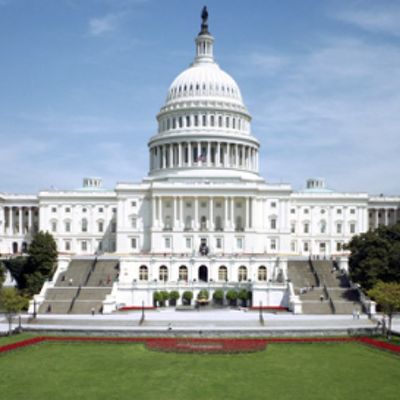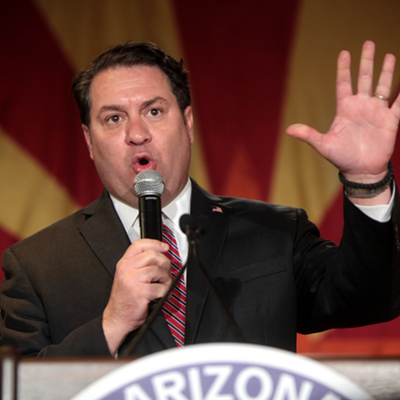THE EARLY SPREAD
Last week, as President George W. Bush was tying up traffic and scaring up a half-million dollars or more for Republican Tim Bee's campaign against Democratic Congresswoman Gabrielle Giffords, we saw our first poll numbers in the Congressional District 8 race.First came a poll from the Bee campaign, which showed Bee just 7 percentage points behind Giffords.
Margaret Kenski, the longtime local pollster who used to survey the district for former congressman Jim Kolbe (and who did the Tucson Weekly/Wick Communications polls in CD8 in 2006), says the mid-May survey puts Bee "within striking distance" of Giffords.
Kenski says Giffords had the support of 47 percent of the 500 likely voters polled, while Bee had the support of 40 percent.
"As an incumbent, you're not comfortable until you're quite a bit past 50 percent," Kenski says. "It's competitive. It's very competitive."
Kenski's 2006 polls never showed GOP nominee Randy Graf within single digits of Giffords.
After the Bee campaign gave us the Big Reveal, a shadowy Washington, D.C., Democratic operative leaked an alternative poll that showed that Giffords with a 24-percentage-point lead over Bee.
When you throw in leaners, Giffords had the support of 59 percent of the 502 likely voters who were surveyed, while Bee had the support of 35 percent. The poll, taken in June by D.C.-based Greenberg Quinlan Rosner, also shows that 57 percent of voters had a favorable opinion of Giffords, while 26 percent had an unfavorable opinion.
How do you end up with such different poll results? It could be anything from bad sampling to disinformation, but they can't both be right.
Kenski has plenty of experience in the district, which leaves us thinking she's closer to the truth. Whatever the numbers are now, we're guessing they'll be a lot closer to Kenski's spread when voters finally cast their ballots in November.
BIG BUY
Republican Tim Bee was probably feeling pretty good about the half-million-dollar haul he brought in during Friday's aforementioned fundraiser, even if some of it has to go to other campaigns, because the $10K photo package--which included an exciting opportunity to meet the doofus-in-chief himself--exceeded the maximum contribution allowed to a congressional candidate of $2,300 for each of the primary and general elections. (Some of that extra dough went to various Republican Party accounts, which will end up being spent on the campaign anyway.)But Bee's cash-induced buzz got a stompin' by the news that the Democratic Congressional Campaign Committee reserved more than $700,000 in television advertising to help out freshman Congresswoman Gabrielle Giffords, according to a report earlier this week in The Washington Post. A reservation isn't a guarantee that the money will be spent. The DCCC could still cancel if they decide Giffords has a big lead.
The reservation could mean that the DCCC crew thinks the race will be closer than the Democratic poll shows. Or it could be a little psychological warfare to take some of the luster off the Bee campaign's Bush fundraiser, which set a new record for a one-day event for a local candidate.
POLL TESTED
The election-integrity gang that has cooked up the notion that the 2006 Regional Transportation Authority election may have been rigged cites a key piece of "evidence" in their arguments: They claim that polls before the election showed the RTA propositions, which approved both a transportation plan and a half-cent sales tax to pay for it, were going down to defeat.Attorney Bill Risner, who has led the charge against the RTA, admitted a few weeks ago that he had never seen the polls that he's citing.
"I'm basing it on information from individuals that I find credible who have told me what they believe--and were told--those poll results were," Risner says.
That got us wondering: Just what did those polls show?
We called political consultant Pete Zimmerman, who ran the campaign promoting the RTA campaigns. Zimmerman was kind enough to share the results of tracking polls from the RTA election.
Guess what? They never showed the RTA propositions losing, although support dropped as Election Day approached.
The surveys, which were done by polling firm Marketing Intelligence, show that back in December 2005, 63 percent of the voters favored the proposition, while 23 percent were opposed, and 13 percent were undecided. Zimmerman says that's typical of past transportation sales-tax proposals in Pima County, which tend to start out strong and then lose support as opponents stab it with their steely knives.
Support for the proposition remained above 50 percent until the beginning of May 2006; about 25 percent of surveyed voters were opposed, while the other quarter were undecided.
The worst day for the sales-tax proposition came on May 6, when 42 percent supported it, and 33 percent opposed it (with 25 percent undecided). But the gap began widening the next day, and by May 13, 46 percent supported the proposition, while 27 percent were opposed, and 27 percent were undecided.
The numbers were so consistent by then that the pollsters predicted the sales tax would have the support of somewhere between 57.3 and 66.3 percent of the voters on Election Day.
The actual result on May 16, 2006: The tax proposition passed with 57.6 percent.
MONEY TROUBLE
State Rep. Tom Prezelski, who is facing six Democratic challengers in the race for two House seats, has yet to qualify for Clean Elections funding.Two of his hard-charging opponents in the Democratic primary, Matt Heinz and Daniel Patterson, both got checks for $19,382 more than a month ago. Ephraim Cruz, another candidate who is pounding on doors across southside Legislative District 29, has applied for funding but had not qualified as of press time.
Prezelski, who never qualified for public funds during his 2006 campaign, says he should be turning in his necessary 220 $5 contributions any day now.
He'd better be, since it can take a week or more to get a check. And time is running out.
Thanks to the new permanent early-voter list that Pima County Recorder F. Ann Rodriguez is introducing this year, somewhere around 7,500 LD29 voters will be getting ballots in about a week.
Given that only 8,600 voters cast a ballot in the 2006 primary, we're guessing most of the people who are going to vote will have their ballots in hand by the first week in August. If we were running, we'd sure like to be able to contact those people as soon as possible.
SEE HOW THEY RUN
Political junkies, take note:• The Democratic candidates in Legislative District 27--Reps. Phil Lopes and Olivia Cajero Bedford and challenger John Kromko--will meet on KUAT Channel 6's Arizona Illustrated at 6:30 p.m., Thursday, July 24. Moderators will be Arizona Illustrated anchor Bill Buckmaster and Tucson Weekly senior writer Jim Nintzel. The program repeats at 12:30 and 5:30 a.m., Friday, July 25.
• Arizona Illustrated will also bring you the Democratic candidates for Pima County District 2--Supervisor Ramón Valadez and challenger Robert Robuck--at 6:30 p.m., Monday, July 28. Moderators will again be Buckmaster and Nintzel. The program repeats at 12:30 and 5:30 a.m., Tuesday, July 29.












